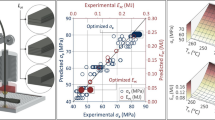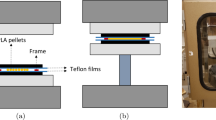Abstract
This study analyzed variations of mechanical characteristics that depend on the injection molding techniques during the blending of short glass fiber and polytetrafluoroethylene reinforced polycarbonate composites. A hybrid method including back-propagation neural network (BPNN), genetic algorithm (GA), and response surface methodology (RSM) are proposed to determine an optimal parameter setting of the injection molding process. The specimens are prepared under different injection molding processing conditions based on a Taguchi orthogonal array table. The results of 18 experimental runs were utilized to train the BPNN predicting ultimate strength, flexural strength, and impact resistance. Simultaneously, the RSM and GA approaches were individually applied to search for an optimal setting. In addition, the analysis of variance was implemented to identify significant factors for the injection molding process parameters and the result of BPNN integrating GA was also compared with RSM approach. The results show that the RSM and BPNN/GA methods are both effective tools for the optimization of injection molding process parameters.
Similar content being viewed by others
References
Brent SA (2005) Plastics materials and processing, 3rd edn. Prentice Hall, New Jersey
Alsewailem FD, Gupta RK (2006) Mechanical properties of rubber-toughened post-industrial glass-fiber-reinforced PA66. Int Polym Proc 21(2):189–197
Chen Z, Liu X, Lu R, Li T (2006) Mechanical and tribological properties of PA66/PPS blend. III reinforced with GF. J Appl Polym Sci 102(1):523–529
SadAbadi H, Ghasemi M (2008) Study on fiber weight fraction effect on tensile modulus of polystyrene (PS) composites reinforced with short glass fiber (SGF) based on their fiber orientation. Polym-Plast Technol 47(4):427–432
Michii T, Seto M, Yamabe M, Kubota Y, Aoki G, Ohtsuka H (2008) Study on warpage behavior and filler orientation during injection molding. Int Polym Proc 23(5):419–429
Biswas SK, Vijayan K (1992) Friction and wear of PTFE—a review. Wear 158(1–2):193–211
Xiang D, Li K, Shu W, Xu Z (2007) On the tribological properties of PTFE filled with alumina nanoparticles and graphite. J Rein Plast Comp 26(3):331–339
Zhang X, Liao G, Jin Q, Feng X, Jian X (2008) On dry sliding friction and wear behavior of PPESK filled with PTFE and graphite. Tribol Int 41(3):195–201
Lin SS, Lin JC, Yang YK (2010) Optimization of mechanical characteristics of short glass fiber and polytetrafluoroethylene reinforced polycarbonate composites via D-optimal mixture design. Polym-Plast Technol 49(2):195–203
Yang YK, Yang RT, Tzeng CJ (2012) Optimization of mechanics characteristics of short glass fiber and polytetrafluoroethylene reinforced polycarbonate composites using the neural network approach. Expert Syst Appl 39(3):3783–3792
Deng WJ, Chen CT, Sun CH, Chen WC, Chen CP (2008) An effective approach for process parameter optimization in injection molding of plastic housing components. Polym-Plast Technol 47(9):910–919
Kung FC, Weng YJ (2008) Optimizations of the processing parameters of high-performance engineering plastic in injection molding. Polym-Plast Technol 47(11):1154–1161
Cheng WS, Chen CS, Chen SC, Chien RD (2009) Investigation of the effects of injection molding processing parameters on conductive polymeric composites for electromagnetic interference shielding effectiveness. Polym-Plast Technol 48(2):216–220
Chen WC, Fu GL, Tai PH, Deng WJ (2009) Process parameter optimization for MIMO plastic injection molding via soft computing. Expert Syst Appl 36(2):1114–1122
Altan M, Yurci ME (2010) Optimization of residual stresses in the surface regions of injection moldings. Polym-Plast Technol 49(1):32–37
Yang YK, Chang TC (2006) Experimental analysis and optimization of a photo resist coating process for photolithography in wafer fabrication. Microelectron J 37(8):746–751
Cao X, Xiao M, Jahazi M, Fournier J, Alain M (2008) Optimization of processing parameters during laser cladding of ZE41A-T5 magnesium alloy castings using Taguchi method. Mater Manuf Process 23(4):413–418
Kurt M, Bagci E, Kaynak Y (2009) Application of Taguchi methods in the optimization of cutting parameters for surface finish and hole diameter accuracy in dry drilling processes. Int J Adv Manuf Technol 40(5):458–469
Badkar DS, Pandey KS, Buvanashekaran G (2011) Parameter optimization of laser transformation hardening by using Taguchi method and utility concept. Int J Adv Manuf Technol 52(9–12):1067–1077
Sushil K, Satsangi PS, Prajapati DR (2012) Optimization of green sand casting process parameters of a foundry by using Taguchi’s method. Int J Adv Manuf Technol 55(1–4):23–34
Montgomery DC (2005) Design and analysis of experiment, 6th edn. Wiley, New York
Tzeng CJ, Yang YK (2008) Determination of optimal parameters for SKD11 CNC turning process. Mater Manuf Process 23(4):363–368
Davim JP, Gaitonde VN, Karnik SR (2008) An investigative study of delamination in drilling of medium density fibre board (MDF) using response surface models. Int J Adv Manuf Technol 37(1–2):49–57
Chuang MT, Yang YK, Hsiao YH (2009) Modeling and optimization of injection molding process parameters for thin-shell plastic parts. Polym-Plast Technol 48(7):745–753
Liu NM, Chiang KT, Horng JT, Chen CC (2010) Modeling and analysis of the edge disintegration in the EDM drilling cobalt-bonded tungsten carbide. Int J Adv Manuf Technol 51(5–8):587–598
Chen CP, Chuang MT, Hsiao YH, Yang YK, Tsai CH (2009) Simulation and experimental study in determining injection molding process parameters for thin-shell plastic parts via design of experiments analysis. Expert Syst Appl 36(7):10752–10759
Deng ZH, Zhang XH, Liu W, Cao H (2009) A hybrid model using genetic algorithm and neural network for process parameters optimization in NC camshaft grinding. Int J Adv Manuf Technol 45(9):859–866
Razfar MR, Zanjani Zadeh MR (2009) Optimum damage and surface roughness prediction in end milling glass fibre-reinforced plastics, using neural network and genetic algorithm. P I Mech Eng B-J Eng 223(6):653–664
Fu ZM, Mo JH (2011) Back prediction of high-strength sheet metal under air bending forming and tool design based on GA–BPNN. Int J Adv Manuf Technol 53(5–8):473–483
Author information
Authors and Affiliations
Corresponding author
Rights and permissions
About this article
Cite this article
Tzeng, CJ., Yang, YK., Lin, YH. et al. A study of optimization of injection molding process parameters for SGF and PTFE reinforced PC composites using neural network and response surface methodology. Int J Adv Manuf Technol 63, 691–704 (2012). https://doi.org/10.1007/s00170-012-3933-6
Received:
Accepted:
Published:
Issue Date:
DOI: https://doi.org/10.1007/s00170-012-3933-6




